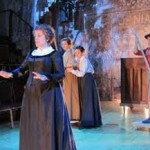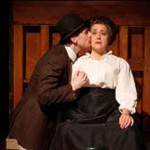Queen of the Mist is a new musical by Michael John LaChiusa (Marie Christine, The Wild Party), which the Transport Group produced at the Judson Gym in the West Village last month. Starring the fiercely charismatic Mary Testa, the musical tells the story of Anna “Annie” Edson Taylor (1838 – 1921), the first person to go over Niagara Falls in a barrel and survive—and on her 63rdbirthday (in 1901), at that.
The musical is significant for placing a middle-aged woman squarely at the center of its narrative. In fact, only one other performer has a stable character part—Andrew Samonsky as Annie’s drunken, rough-hewn, opportunistic manager, Frank Russell. The rest of the cast is a quintet of terrific actor/singers who cycle through a number of subsidiary roles, all written to support the journey of the central character.
Testa more than meets the challenges of a role that requires her to be a stalwart, pragmatic single woman in an age when women were much more often domesticated in heterosexual nuclear families. Annie is a dreamer, a woman who insists, in one of the show’s best songs, “I have greatness in me.” How often do we see musicals about older, single women determined to actualize their dreams?
The show’s structure, as well as its story, makes it unique. This is not a typical “opposites attract,” heterosexual love story that resolves the relationships and the musical world’s metaphorical social divisions by the performance’s end. Instead, Queen of the Mist keeps Annie alone throughout, and her relationship with Russell one of affection and grudging love, but not romance. This makes Annie a remarkably original character even by present-day standards, let alone for an actual historical woman who came of age in the 19th century.
Before her idea to ride over the falls coalesces, Annie tries and fails to make economic ends meet through various schemes. Queen of the Mist’s book cleverly introduces us to her through long monologues of cunning and manipulation meant to distract her landlords and buy her time to pay her rent. In one scene after another, she’s evicted from her lodgings.
Annie tells stories about once having been married, though she never was. She lies about her age, moving herself nicely (over the course of a scene or a song or two) from 47, through her 50s, to 63, her actual age when she did what she called her “deed.”
Her sister, Jane, who lived with her husband and children in Auburn, New York, provides Annie’s gender foil. Ensemble-member Theresa McCarthy is wonderful as the pinched, submissive woman, who was happy to be a mother and wife, with no ambitions but to make her home. Annie wanted much more than that. Her outsized expectations chafed at her brother-in-law, who insisted Annie leave his house on the one occasion Jane rescued her sister from indigence.
Annie’s single-minded passion to distinguish herself and to make “the green” (as she calls money) keeps her from intimacy with her family or her few friends. She carefully planned out her ride down the falls, ordering a specially constructed, scientifically designed barrel and attending to the details of the stunt’s public relations as much as to the rudimentary technology that she hoped would save her life.
Annie persuades Russell to be her manager so that he can carry out her plan for how her stunt will appear to the public. Russell is an alcoholic accustomed to exploiting his clients, but he’s fascinated by Annie’s work ethic. His surprising affection for this unusual woman is quite moving in Samonsky’s subtle rendition. He can’t emulate her strict morality; in fact, he steals her barrel after her successful trip down the falls, and employs an impersonator to play Annie in a seedy burlesque about her deed.
The raw space of the Judson Gym was designed for Queen of the Mist to evoke the banks of the river that runs into the rushing waters of Niagara Falls. The divided audience sat on risers facing each other across the narrow playing space, with two smaller playing spaces at either end. The intimacy of the stage meant that Testa could easily project Annie’s majesty into the audience.
Testa inhabited fully a role that seems to have been written for her. Her carriage perfectly erect, her hands quiet at her sides, she used her face and her eyes and her large eloquent voice to command the stage, communicating the power and determination of a woman who had to live by her wits in an age when women had few opportunities for agency.
Queen of the Mist underlines how unseemly it was for women to seek public attention at the turn of the 20th century. Nevertheless, Annie did go down in history as the first person to survive the plunge down Niagara Falls.
But after she accomplishes her dream, Annie becomes strangely distanced from herself and her adoring but finally impatient public. Queen of the Mist’s second act quiets her down a bit and the show loses some of its focus and verve.
It’s not quite clear whether Annie is supposed to be disappointed about the reception to her stunt and how quickly she passes from the public eye, or if something else has suddenly drawn the wind from her considerable sails. She also begins to lose her eyesight. LaChiusa seems uncertain whether this is meant to be metaphorical or simply factual.
Finally, then, despite its considerable charms, Queen of the Mist seems a bit unsure what it’s about. Is it a Floyd Collins-style indictment of the press and the way that it did or didn’t make heroes of people? The press badgers Annie for years to share the specifics of what she felt in that barrel as she moved down the river toward the falls. But Annie believes the fact that she did the deed should have been enough. In the show’s 11th hour revelation scene, after much prompting and suspense, Annie finally confesses what she felt during her ride down the falls. She bares her heart as she describes her terror and her love for all those she feared she might never see again.
But Queen of the Mist doesn’t explain why she was reluctant to share these details all along, and what her hesitancy means for the story’s larger implications. Does the show mean to suggest that Annie should have been more emotionally available in her life? That a kind of emotional hubris was her downfall?
Or does the show respect Annie for refusing to pander to sensationalism by describing her emotions and the terrifying sensation of plummeting over the falls, in the dark, with pounding water pummeling the thin wooden membrane between your body and your death?
Hard to say. In a talk-back after the performance we saw, Testa and director Jack Cummings III said that Annie wanted to “own” her story, and felt that the fact of her deed was enough. We weren’t quite sure, however, that the show itself made that clear.
Nonetheless, Queen of the Mist has wonderful potential and a terrific cast who spoke eloquently about the project. Here’s hoping Annie Edson Taylor gets another chance at fame.
The Feminist Spectator
Queen of the Mist, Judson Gym, December 1, 2011.








